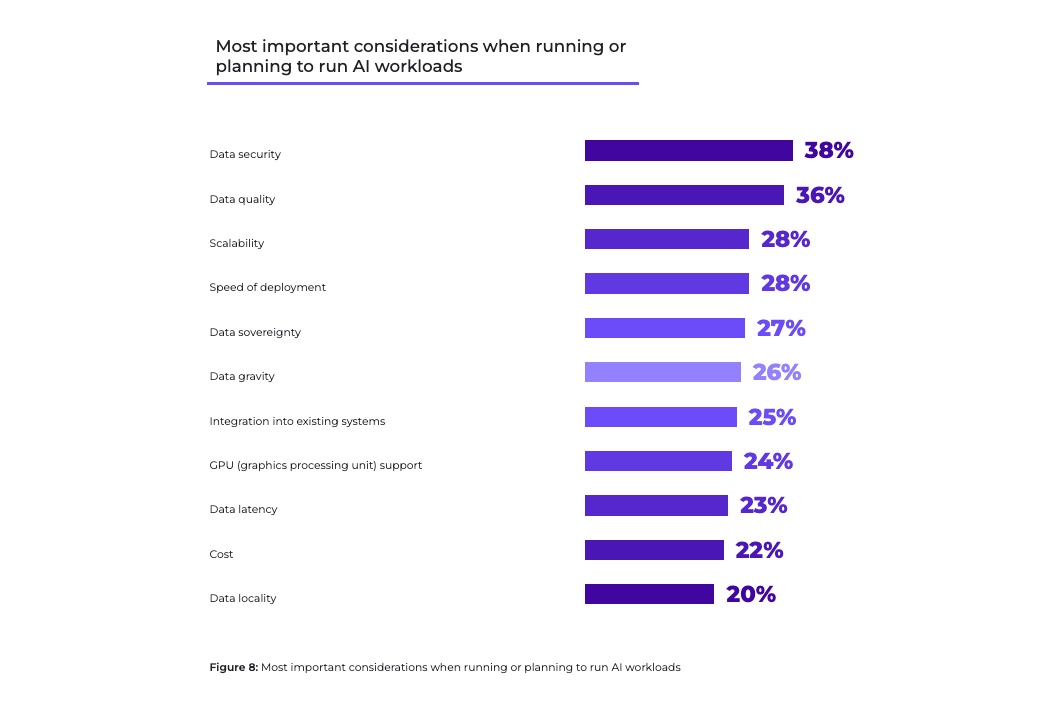Many saw it coming and braced. Others saw it move from hype to a business imperative almost overnight. Now, according to a new report on artificial intelligence readiness, 9 out of every 10 IT leaders say artificial intelligence (AI) is a top priority for their organization. Yet most lack IT infrastructure and skills needed to support new AI goals. This is forcing them to make substantial investments in order to adopt and scale the use of AI.
The 2023 Nutanix State of Enterprise AI Report, based on input from over 650 IT, DevOps and platform engineering decision makers, reveals the immense impact AI is having on IT strategies and resources.
Findings show 90% of respondents emphasize AI security and reliability as a top concern, and most plan to enhance data protection and data recovery capabilities. The report also showed that AI isn't confined to one location, as 83% of respondents plan to boost their AI edge strategy investment. A major concern is that today’s IT infrastructure wasn’t built for AI, as 91% of respondents agree it's time to modernize.
“It's probably simultaneously exciting and terrifying to be a data center manager right now,” Greg Diamos, a machine learning systems builder and AI expert, told The Forecast. “You don't have enough compute in your data center, no matter who you are.”
Some key findings include:
- 90% consider AI a priority
- 92% expect IT costs to increase due to AI applications and services
- 85% plan to increase investments to modernize IT infrastructure over the next 1-3 years to support AI workloads
- 84% plan to increase investments to expand their data science and engineering teams
- 90% say security and reliability are important considerations in their AI strategy
The report showed enterprises are putting AI to work through generative video, text and image applications, and to deliver virtual assistance and customer support. AI-based solutions for fraud detection and cybersecurity, and a range of image recognition, speech recognition and computer vision applications also appeared atop the list of current or planned uses.
And these are still early days for AI, according to Debojyoti “Debo” Dutta, vice president of engineering for AI at Nutanix. He helped Nutanix build and release GPT-in-a-Box, a full-stack software-defined AI-ready platform with services designed to simplify and jumpstart AI initiatives.
“AI-based solutions and services are not a fad,” Dutta said.
He pointed to the meteoric rise of generative AI applications such as ChatGPT that are already making a big impact yet are revealing some big challenges.
“People and businesses will use generative AI to get ahead of those who don't use generative AI,” he said. “But it is such a new technology that many organizations today don't have tools and skills to build and implement these capabilities on their own.”
Pressure is mounting on IT teams that have to figure it out and get it right as their company invests in their AI-powered future.
Data Privacy and Protection a Top Concern
Protecting valuable data and intellectual property (IP) is a big challenge for everyone. Data security and data quality were by far the most important considerations when running or planning to run AI workloads, according to AI report.
“There are a lot of cloud service providers and SaaS products for generative AI, many are thinking hard about whether or not to use them because of the data privacy and the inherent protection challenges,” Dutta said.
“An organization's real intellectual property is its data, so that data needs to be guarded and protected as any valuable asset. Many don't want to relinquish any control of that data.”
The survey findings showed that AI technologies will drive the need for new backup and data protection solutions. Over half of respondents are planning to add mission-critical, production-level data protection and Disaster Recovery (DR) solutions to support AI data governance. And half are planning to define data protection and governance strategies within edge environments to support AI.
“Security professionals are racing to use AI-based solutions to improve threat and anomaly detection, prevention and recovery while bad actors race to use AI-based tools to create new malicious applications, improve success rates and attack surfaces, and improve detection avoidance,” said Dutta.
Dutta said that while some are ahead of the curve, many organizations are getting up to speed with these novel technologies and have a sizeable gap between the development of AI-based solutions and actually running these solutions in production.
“Overcoming this gap will be a long journey, one which will drive many organizations down a path of infrastructure modernization and expansion to meet the requirements of this new breed of solution,” he said.
IT Infrastructure Needs
AI capabilities come with a cost. Generative AI, for example, is a very intense workload that requires robust computing and storage resources, especially at the core data center, and modern infrastructure for managing edge locations from afar. Those IT systems need to interconnect and scale. They need to host, move and protect applications and data. They need to be kept up to date, always on and run efficiently.
“This ubiquitous workload will drive a lot of AI infrastructure modernization because, for the most part, many companies cannot run today's gen AI workloads,” Dutta said. “These workloads are too data-intensive.”
While 85% of respondents plan to purchase existing AI models or leverage existing open-source AI models in order to build their AI applications, only 10% of respondents indicated they plan to build their own models. Either way, these applications and services require systems that can handle a tremendous amount of data, Dutta said.
To meet expanding data requirements, 91% said they need to make long-term investments in IT infrastructure modernization to support and scale AI workloads. Notably, 85% of respondents say their organization plans to increase investments in IT infrastructure modernization over the next 1-3 years to support AI workloads. Data security (53%), infrastructure resilience and uptime (52%), infrastructure management at scale (51%), and infrastructure automation (50%) were some of the areas in need of investment to support AI goals.
Running AI Across IT Architectures
A majority of survey respondents said they currently deploy AI applications on virtual machines (VMs), while 62% said they currently deploy AI applications on containers, indicating the use of AI technology across different enterprise IT environments – both virtualized and cloud-native.
“AI-based services and applications are absolutely made for hybrid multicloud architectures,” said Induprakas Keri, senior vice president and general manager of hybrid multicloud at Nutanix.
“Steps in the AI workflow will happen across various infrastructure environments, with training happening in the cloud, enrichment, refinement, and training in core data centers, and inferencing at the edge. Successfully delivering a cohesive, scale-out infrastructure that can span across this entire AI workflow will be a key to success.”
Whether intentionally or accidentally, most enterprises rely on hybrid or hybrid multicloud IT operations. When it comes to deploying AI applications, the State of Enterprise AI report showed 93% believe in deploying an edge strategy to support AI plans, and 83% are willing to increase investments in an edge strategy over the next 1-3 years. More than half of respondents need to improve how they transfer data between cloud, data center, and edge environments to support AI data initiatives.
AI Skills Gap
Most organizations are aware of the need to invest in the people and skills needed to support AI initiatives. In the State of Enterprise AI Report, 84% of respondents said they plan to increase investments to expand their data science and engineering teams over the coming years. Generative AI and prompt engineering, and data science or data analytics were identified as the top two areas in need of more AI skills development over the next 12 months.
“The AI skills gap is twofold,” said Dutta. “First, there is a lack of people to build AI-based tools, services, and the infrastructure to support them. Second, there aren’t enough skilled and trained professionals to apply AI-based tools and services within their organization or industry vertical. Technology providers will be essential to help overcome or at least supplement skills shortages in both areas.”
The report findings indicate that many organizations will look to overcome AI-related skills gaps by simply buying packaged solutions and services – as opposed to executing and managing every step in the AI/ML workflow themselves.
Editor’s note: Learn more about the Nutanix platform for AI, including Nutanix GPT-in-a-Box, a full-stack software-defined AI-ready platform designed to simplify and jump-start your initiatives from edge to core.
Ken Kaplan is editor in chief of The Forecast. Find him on X @kenekaplan.
© 2023 Nutanix, Inc. All rights reserved. For additional legal information, please go here.










